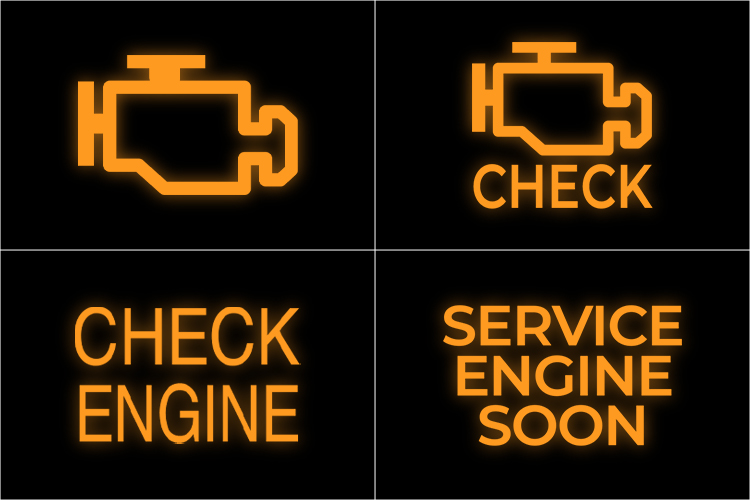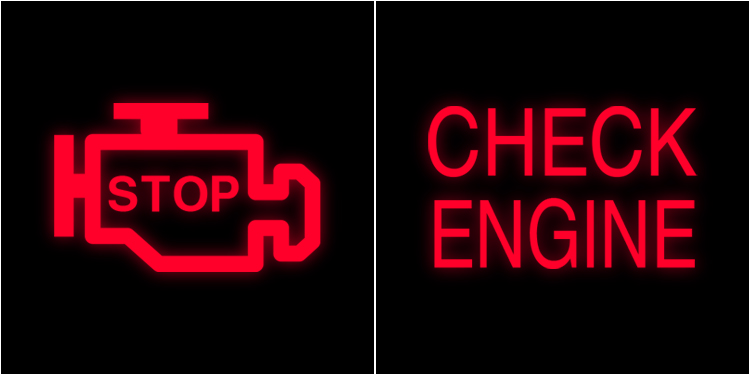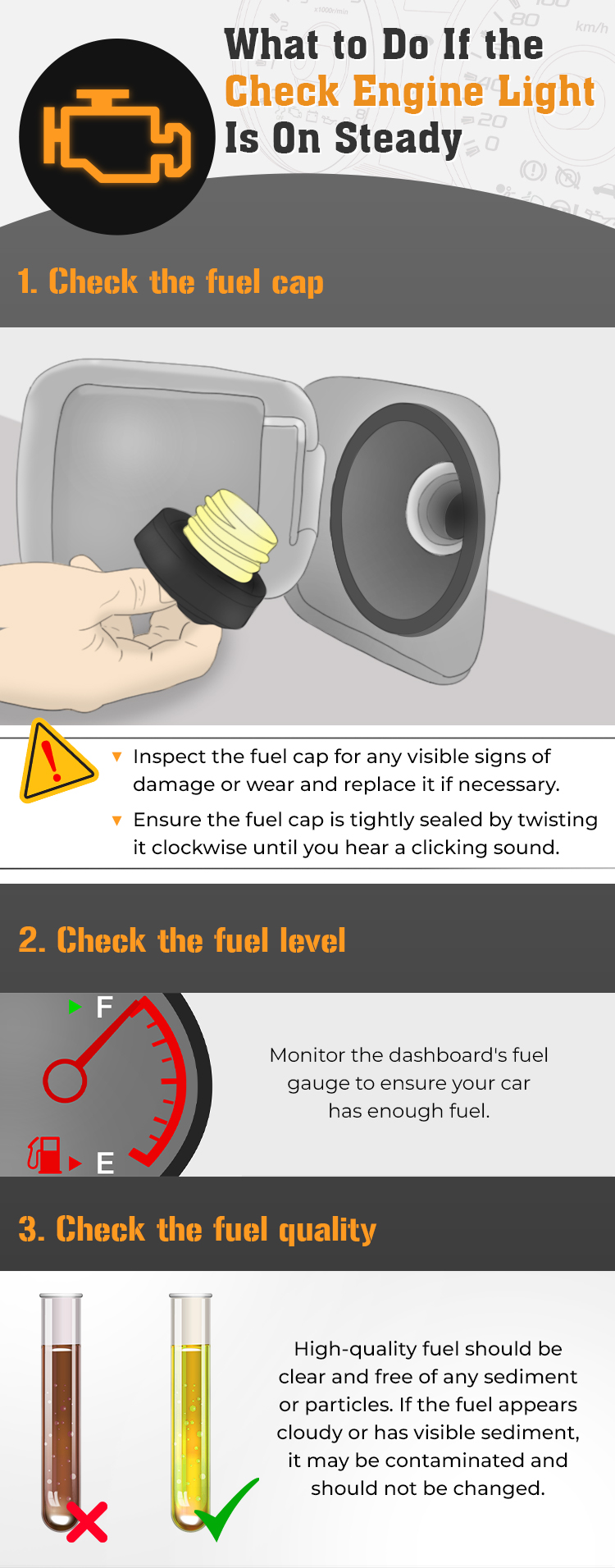Seeing the check engine light appearing on your dashboard?
You might be wondering:
But don’t panic!
In this article, I will answer your questions about the check engine light, including its meaning, causes, and how to diagnose and fix the problem.
Ready to get started?
What Does the Check Engine Light Mean?

Check engine light, also called malfunction indicator lamp (MIL), is part of your vehicle’s onboard diagnostic (OBD) system, which monitors almost every component that can affect emission performance. Once a malfunction is detected, the OBD system will trigger the check engine light to alert you.
When the ignition switch is on, the OBD system will perform a self-test and trigger the check engine light to come on for a few seconds. When the engine is started, the light should go off.
However, if the check engine light stays on or flashes while driving, it indicates there is a malfunction with emission-related components. You can judge the problem’s severity based on the status of the light:
- A steady check engine light indicates a minor problem such as a loose, damaged, or missing gas cap, low-quality fuel, etc. You can still drive but should have your car checked as soon as possible.
- If the light flashes or blinks, it means a more severe problem like an engine misfire or catalytic converter damage. In this case, you should stop driving and have your car inspected immediately.
In some vehicles, a red check engine light indicates a much more severe problem. If it appears on your dashboard, stop driving immediately and call a tow truck to the nearest repair shop.

Is It Safe to Drive With the Check Engine Light?
No. Driving with the check engine light on can lead to further damage to your car, costly repair, and even a breakdown on the side of the road.
As mentioned above, if the check engine light is on steady, you can drive. However, your car might switch to limp mode, making you experience a significant reduction in power and acceleration.
Additionally, the transmission might be restricted to certain gears or shift patterns. This poses challenges to driving in such situations as merging onto a highway or climbing a steep hill.
Some added features like Hill Start Assist, Traction Control, and Stability Control may be disabled. Thus, be cautious and take your car to a certified mechanic to diagnose and repair the malfunctioning component soon.
In case the check engine light flashes or blinks while driving, you should pull off the road and call a tow truck to avoid further damage.
Why Is My Check Engine Light On?
Loose or Damaged Fuel Cap
The gas cap seals the fuel tank and helps maintain pressure in the evaporative emission control (EVAP) system. When the gas cap is loose, damaged, or missing, it allows fuel to evaporate into the atmosphere. The OBD system will detect leaks in the EVAP system and trigger the check engine light.
Simply tightening or replacing the gas cap can solve the issue. The light will turn off after a few driving trips.
Poor Fuel Quality
Poor fuel quality sometimes causes the check engine light to come on, but it’s not a very common cause. If the fuel contains a high amount of water or other contaminants, it could potentially damage the fuel injectors or other engine components. The OBD system will detect the damaged components and tell you through the check engine light.
In this case, change the fuel. You also need at least one full tank of the proper fuel to turn the light off.
Malfunctioning Oxygen Sensor
The oxygen sensor measures the amount of oxygen in the exhaust gases of an internal combustion engine. If the oxygen sensor is malfunctioning, it may send incorrect information to the ECM, resulting in an improper air-fuel mixture. This can cause the engine to run poorly, reduce fuel efficiency, and increase emissions. To alert the driver of this issue, the ECM triggers the check engine light.
Failing Mass Air Flow Sensor
The mass air flow (MAF) sensor measures the air entering the engine. If the MAF sensor is not working properly, it may send incorrect information to the ECM. Thus, the system can’t adjust the correct amount of fuel to inject into the engine. The check engine light will come on to inform the problem.
Faulty Catalytic Converter
The catalytic converter is responsible for converting harmful pollutants in the exhaust into less harmful gases. If it fails, you may notice a drop in its efficiency and the check engine light coming on.
Issues With the Ignition Coil or Spark Plugs
The ignition coil and spark plugs work together to ignite the fuel in the engine. If they’re not functioning correctly, it can cause the engine to misfire, resulting in decreased performance and increased emissions.
Failing Thermostat
The thermostat regulates the engine’s temperature. If it’s not working correctly, it can cause the engine to overheat, which can cause serious damage and trigger the check engine light.
Incompatible Aftermarket Components
In addition to the aforementioned common causes, you need to pay attention to any recent modifications made to your vehicle. Because aftermarket components that have been replaced may not be compatible with the system. For example, installing a cold air intake or exhaust system may change how the engine operates and trigger the check engine light.
What If the Check Engine Light Comes on With Other Lights
Note that besides the emission control system, the OBD system also monitors various systems, including engine, transmission, ABS, airbag system, etc. Thus, it’s not uncommon to see multiple warning lights at the same time.
While these warning lights are not directly related to each other, in some cases, they come on due to a common underlying cause. For example, if there is a problem with the car’s electrical system that is affecting both the battery and the engine sensors, the battery warning light and the check engine light may both come on.
In any case, you should have your car checked by a professional mechanic to determine the cause of the problem and make any necessary repairs. Ignoring these warning lights or continuing to drive the car with them can potentially lead to more serious issues and costly repairs down the line.
What to Do When the Check Engine Light Comes on
If you’re uncertain or unable to address the issue with the check engine light, taking your car directly to the nearest repair shop is the best course of action. However, in some instances, you may be able to identify and fix the problem yourself. With that in mind, I will offer some practical steps you can take to save money on repair costs potentially.
What to Do When the Check Engine Light Is On Steady

First, inspect the fuel cap for any visible signs of damage or wear, and replace it if necessary. Make sure the fuel cap is tightly sealed by twisting it clockwise until you hear a clicking sound.
Next, visually inspect the fuel for any signs of contamination or discoloration. If necessary, switch to high-quality fuel to help keep your engine running smoothly and reduce the risk of fuel-related problems. Also, be sure to check the fuel gauge on the dashboard and ensure that your car has enough fuel.
Keep in mind that it may take several trips before the light resets. Until then, you should follow the instructions below to prevent serious damage:
- Reduce vehicle speed
- Avoid hard acceleration or deceleration
- Avoid steep uphill grades
- Reduce the amount of cargo
What to Do When the Check Engine Light Flashes

Step 1: Use an OBD2 scanner to identify the cause
When the OBD system detects a malfunction, the information about the malfunctioning component is stored in diagnostic trouble codes (DTCs). By using a scan tool, you can figure out the code meaning, identify the source of the problem and fix it.
Many auto parts stores offer free code-reading services. However, it’s best to have a scanner to perform a diagnostic test whenever you need it.
Here are the steps to follow:
- Turn off the engine.
- Connect the scanner to the OBD2 port. Most scanners will have a cable that plugs into the port, while others may be wireless.
- Turn on the ignition.
- Follow the scanner instructions.
- Select the “Read Codes” function on the scanner.
After that, figure out what the codes mean by using the DTC Lookup Library on the scanner or going to the OBD2 Codes Lookup to find meaning, causes, symptoms, and how to fix it.
Step 2: Repair the malfunctioning parts based on the codes
You can replace or repair the malfunctioning part with enough car knowledge and tools. Otherwise, get your car to a professional for inspection and repair.
Step 3: Reset the check engine light
Note that only reset the check engine light after you diagnose and fix the problem.
Method 1: Restart and drive for 50 – 100 miles
In certain vehicles, once the underlying issue has been addressed, the check engine light will go off after 50 to 100 miles on the road.
Method 2: Use an OBD2 scanner to clear the codes (Highly Recommended)
For various reasons, the DTCs may still remain stored in your car’s computer. In such cases, you should use an OBD2 scanner to clear the DTCs completely. Most scanners offer a “Clear codes” function, which can be selected to erase the codes from your car computer.
Next, restart your engine and go for 50 – 100 miles. The check engine light will be gone, and the problem will be solved!
Method 3: Temporarily disconnect your car battery
Some blog posts and Youtube videos suggest disconnecting the battery to reset the check engine light. I agree that this common DIY method may work in some cases. However, it is not a reliable way and causes other issues with your vehicle’s computer system.
The unintended consequence is the loss of memory settings, including adaptive learning, fuel trim, idle speed, etc. This can cause the engine to run rough or stall until the ECM re-learns these settings.
By the way, if you want to try to use this method, watch the video below. It shows detailed steps to turn off the check engine light.
What’s Next?
The check engine light can indicate a range of issues with your vehicle, from minor problems to severe issues that require immediate attention. But don’t panic! Referring to my guide, I believe that you can control the situation and take some necessary steps to protect yourself and your car. If you encounter different situations while driving, feel free to share them with me in the comment box below.
In case you feel unsure about your decision, seek the help of a qualified mechanic.
And here are two key takeaways:
- Whether you are a car owner, enthusiast, or professional mechanic, have a scan tool to self-diagnose your car and make any necessary repairs. You can read my OBD2 scanner review post to pick the best suit for you.
- By performing regular maintenance on your vehicle, you can limit the chance of seeing the check engine light and keep your vehicle running smoothly.


Recommended for you
What Does Eco Mean on Car? When to Use?
Triangle with Exclamation Point: What Does It Mean?
Behind the Traction Control Light: Meaning, Causes, & Fixes